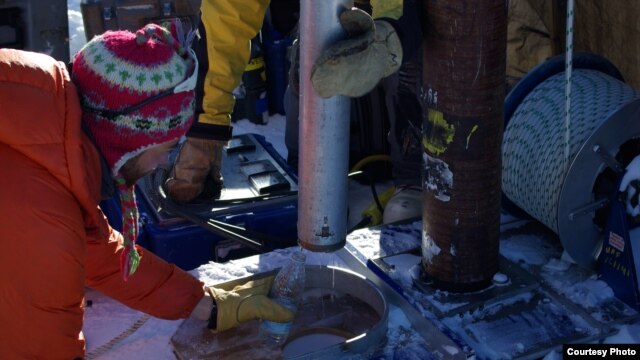December 23, 2013
A
massive lake has been found under the ice in Greenland. The 43,500
square kilometer body of water could have major implications for
understanding sea level rise.Researchers at the University of Utah say the lake, known as a “perennial firn aquifer,” remains liquid year-round despite the otherwise perpetually frozen landscape.
“Large amounts of snow fall on the surface late in the summer and quickly insulates the water from the subfreezing air temperatures above, allowing the water to persist all year long,” said Rick Forster, lead author and professor of geography at the University of Utah.
The Greenland Ice Sheet is vast, covering roughly the same area as the states of California, Nevada, Arizona, New Mexico, Colorado and Utah combined. The average thickness of the ice is 5,000 feet. In 2012, the ice sheet lost volume of 60 cubic miles – a record for melt and runoff.
Read More Here
.....
Greenland's Snow Hides 100 Billion Tons of Water
By Becky Oskin, Staff Writer | December 22, 2013 01:00pm ET

A drill rig was used to extract old snow (firn) cores from within the Greenland snow aquifer. Credit: Evan Burgess
Big surprises still hide beneath the frozen surface of snowy Greenland. Despite decades of poking and prodding by scientists, only now has the massive ice island revealed a hidden aquifer.
In southeast Greenland, more than 100 billion tons of liquid water soaks a slushy snow layer buried anywhere from 15 to 160 feet (5 to 50 meters) below the surface. This snow aquifer covers more than 27,000 square miles (70,000 square kilometers) — an area bigger than West Virginia — researchers report today (Dec. 22) in the journal Nature Geoscience.
"We thought we had an understanding of how things work in Greenland, but here is this entire storage system of water we didn't realize was there," said Richard Forster, lead study author and a glaciologist at the University of Utah.
The discovery will help scientists better understand the fate of Greenland's annual surface melt, which contributes to sea level rise. When the summer sun warms the Arctic island, a giant water world of stunning blue lakes and streams appears atop the ice. Tracking this surface runoff helps scientists account for ice lost to melting each year. Until now, researchers thought most of this water went to the ocean or refroze on the ice. Now they've found a new hiding place.
"This throws an additional complexity into the system," Forster told LiveScience.
There is enough water in the snow aquifer to raise global sea level by 0.015 inches (0.4 millimeters), according to a separate study by the same team published Nov. 30 in the journal Geophysical Research Letters (GRL). Every year, Greenland adds 0.03 inches (0.7 mm) of water to global sea level rise from melting snow and ice, Forster said. [Top 10 Surprising Results of Global Warming]
Where water flows
No one yet knows how old the water in the aquifer is, and whether it stays trapped in the snow or reaches the ocean in slow streams or catastrophic floods. However, the top of the water table rose after Greenland's huge surface melt in 2012, the researchers report in their GRL study.

Water from the Greenland snow aquifer draining from a drill core
extracted 40 feet (12 meters) below the surface of the ice sheet in
April, before the summer surface melt, with air temperatures of 5
degrees Fahrenheit (minus 15 degrees Celsius).
Credit: Ludovic Brucker
The
group will return to southeast Greenland in the coming years to answer
these and other questions, Forster said. "Just seeing how old it is
would answer a lot of questions," he said.Credit: Ludovic Brucker
The final destination of Greenland's melt water is also key to understanding how the ice sheet ebbs and flows, because water under the ice sheet lubricates flowing glaciers. Researchers know some melt water goes to the bottom of the ice, trickling through cracks and racing through vertical pipes called moulins. Some of the water also simply refreezes on the surface when winter comes. Liquid water sitting in buried snow layers can also slowly warm and melt the ice sheet.
"The existence of this rather flavorless natural snow cone has many implications for the future of the ice sheet, some that may make the ice go away faster and others that help keep the ice a little longer," said Richard Alley, a glaciologist at Pennsylvania State University, who was not involved in the study. "We would like to understand these implications better so we can help reduce the uncertainties about future changes."
Read More Here
.....











No comments:
Post a Comment
Hello and thank you for visiting my blog. Please share your thoughts and leave a comment :)